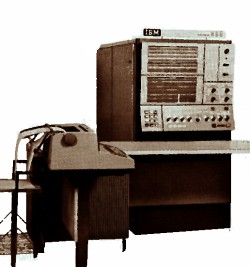Milestones: the IBM System/360

I tend to be fascinated by large industrial organizations, and the effect they have on technology in particular. It seems to me that, in a way, a lot of the major technical breakthroughs that allowed industry to occur did so centuries before the industrial revolution, during a period known as the commercial revolution. The ability of the large industrial organization to take on fundamentally more demanding, complex, and permanent tasks than any prior entity was always a precursor to any major transforming technology.
 Much is made of the computer as such a technology, though the word "computer" actually refers very large family technologies. One these technological breakthroughs was creation of a series of processors that possessed a similar architecture and which differed chiefly on basis of size. Prior this time, the term "series" was used to describe computers with little more in common than manufacture by same company. The IBM 700/7000 series, for example, consisted of entirely redesigned machines, although a couple of machines could run programs produced for an earlier version. Part of the problem was, of course, the underlying evolution of electronics was proceeding much too fast to permit stable designs. Another possible challenger for the title, the UNIVAC 1100 series, suffers from the fatal flaw of having the second model in it introduced contemporaneously with IBM's entire S/360 line-up of six machines.
Much is made of the computer as such a technology, though the word "computer" actually refers very large family technologies. One these technological breakthroughs was creation of a series of processors that possessed a similar architecture and which differed chiefly on basis of size. Prior this time, the term "series" was used to describe computers with little more in common than manufacture by same company. The IBM 700/7000 series, for example, consisted of entirely redesigned machines, although a couple of machines could run programs produced for an earlier version. Part of the problem was, of course, the underlying evolution of electronics was proceeding much too fast to permit stable designs. Another possible challenger for the title, the UNIVAC 1100 series, suffers from the fatal flaw of having the second model in it introduced contemporaneously with IBM's entire S/360 line-up of six machines.What distinguished the System/360 was that it had been conceived as an architecture before it was designed as a machine. The fleet was to have the same instruction set and numerous other common features, making it possible for the fleet to use (in theory) the same operating system. The memory was standardized and plug-compatible, making it possible to add modular components and replace them with newer models. Interestingly, Gene Amdahl's original paper outlining the design principles of the S/360 (PDF) divulges that his team chose the 4/8 bit word (which hereafter became universal) for coding efficiency in business applications. Numeric data, which was most efficiently expressed in floating point form, was the most common form of data. The 4/6 bit word was compatible for 16-bit instruction field and 32-bit floating point word.
The major design breakthroughs of the S/360 were fairly slow in coming; a uniform operating system for the family was not fully available until 1967 [*]. The OS/360 was obligated to be scalable upward from fairly modest operational capabilities to the largest computers available; in later verions, it would support multiple processors and virtual memory addressing.
This is significant because it stimulated the focus on designing machines varying greatly in capacity or purpose, while ensuring that components were interchangable, and could communicate with each other. It stimulated the faster cross-pollination of technologies across platforms and use of direct machine-machine communication. Finally, in 1975, the 370 was the first computer to be cloned by a competitor: the Amdahl 470, designed by Gene Amdahl himself, was greatly superior to the IBM System/370 and quickly captured 20% of the market for IBM-compatible computers.
ADDITIONAL READING & SOURCES: Wikipedia S/360 & S/370
Architecture of the IBM System/360, by Gene Amdahl;



0 Comments:
Post a Comment
<< Home